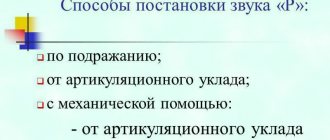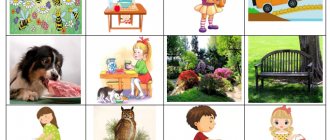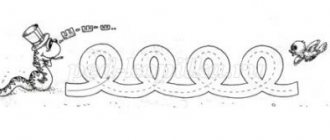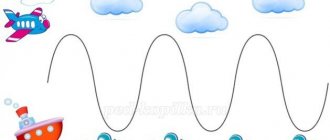Characteristics of the development of a 3-4 year old child
At 3 years old, the child is open to learning his native language, he happily repeats everything after an adult and is actively engaged in word formation. By the age of 4, the passive vocabulary reaches 2,500 words, most of which are verbs and nouns.
The child’s speech also contains:
- simple adjectives (beautiful, small, big);
- possessive pronouns (my);
- generalization words (animals, vegetables).
A preschooler does not yet have much life experience and produces new words in his own way. This gives rise to curious word forms, for example: “Mom is studying, but I am a lazybones.” A three-year-old child is able to maintain a simple dialogue.
The most difficult sounds to pronounce are “R” and “L”, as well as the whistling “Sh”, “S”, “F”. Often, even after reaching four years of age, the child is not able to pronounce them.
Important! If at 3-4 years old a child does not pronounce all sounds clearly, this is not a reason to run to a speech therapist.
The sounds “R”, “L”, “Sh”, “S”, “F” are usually introduced at a later age. However, if by the age of 3 the baby does not speak at all, and there were serious illnesses or injuries during pregnancy/birth/in the first year, consultation with specialists is required. Based on the results of the examinations, a psychologist, speech therapist and neurologist will tell you what speech therapy exercises for children 3-4 years old should be performed.
Groups of words suggested for memorization.
1. Subject dictionary.
Toys: ball, cube, car, doll, bear, bunny, ball, spinning top, bucket, shovel, pencils, book, etc. Parts of the body, face: legs, arms, belly, back, finger, head, neck, hair, eyes , ears, mouth, lips, teeth, nose, cheeks, eyebrows, forehead. Clothing and footwear: hat, scarf, mittens, jacket, coat, dress, skirt, blouse, shirt, trousers, tights, briefs, T-shirt, socks, slippers, boots, shoes, sandals, etc. Toilet items: soap, toothbrush, toothpaste, sponge, towel, comb, handkerchief, etc. House, apartment: house, door, lock, key, stairs, elevator, window, kitchen, room, bathroom, lamp, floor, ceiling, wall, etc. Furniture: table, chair, sofa, bed, wardrobe, shelf, hanger, etc. Household items: TV, telephone, clock, stove, refrigerator, fork, spoon, plate, cup, blanket, pillow, mirror, etc. Food and dishes : bread, bun, cheese, sausage, sausages, milk, butter, sour cream, cottage cheese, yogurt, cookies, juice, egg; porridge, soup, salad, sandwich, tea, compote, etc. Vegetables and fruits: cabbage, potatoes, carrots, onions, cucumbers, tomatoes; orange, banana, apple, pear, plum, etc. Plants: tree, bush, grass, flowers, berries, etc. Names of animals and birds that the child often sees: dog, cat, bird, dove, sparrow, crow, horse, etc. etc. Individual names of objects in the surrounding life: street, road, traffic light, cars, plane, swing, slide, park, etc. Individual names of phenomena in the surrounding life: water, earth, sun, sky, rain, snow, night, day, etc.
2. Verb dictionary.
The child’s own actions: walks, sits, stands, runs, jumps, sleeps, eats, plays, draws, builds, walks, rolls, washes, bathes, dresses, undresses, combs his hair, carries, falls, screams, speaks, sweeps, wipes and etc. Names of actions that people close to the child perform: reads, writes, draws, cleans, washes, irons, cooks, fries, sweeps, etc. Other actions: the phone rings; the car drives and hums; The plane is flying; leaves are falling, etc.
3. Adjectives, adverbs.
Names of some sensations and states: sweet, salty, sour, wet; cold, warm, hot, painful, tasty.
The name of some concepts: big, small; a lot, a little.
Work to expand the passive vocabulary of non-speaking children 2-3 years old is carried out both by a speech therapist and by the child’s relatives. Therefore, a speech therapist not only works with the child, but also works with parents.
Possible causes of violations
Disturbances in the speech development of a preschooler may be associated with medical indicators or the child’s social environment.
Medical reasons:
- Mother's illnesses during pregnancy, smoking, alcoholism and drug addiction;
- Birth injuries and other complications;
- Head injury in the first 3 years of the baby;
- Left-handed child;
- The special structure of the articulatory apparatus;
- Heredity and genetic predisposition to speech disorders.
Social environmental factors:
- The baby hears little correctly delivered speech, adults are not interested in constant communication with him;
- Adults speak incorrectly (with mistakes, burr) or “lisp” with the child. As a result, by repeating, the baby remembers this manner of speech;
- An adult demands to pronounce the sound correctly, but at the same time does not show correct articulation. Often this leads to incorrect sound production, which subsequently has to be corrected (for example, “R” is pronounced with the throat).
What do speech therapists advise?
Seven simple and wise tips from speech therapists will help adults correctly structure their communication with their child so that his speech develops quickly. Let's list each of them:
- Support and encourage the child's activity, openly express joy when the baby tries to pronounce sounds and syllables.
- Help your treasure, buy educational games. Puzzles, cut-out pictures, cubes with pictures, insert games will help develop fine motor skills.
- Come up with finger games for your little one. The fingertips are replete with nerve endings that influence the stimulation of the motor area of the brain. A simple game has long been invented in which each finger is given the name of a family member. Touch your baby's fingers and come up with different stories so that all the fingers are included in the plot.
- Be sure to read books with your child, tell him fairy tales, memorize poems, and sing songs. Take as your assistant the works of famous children's writers (Mikhalkov, Barto, Bianchi, Marshak, Chukovsky).
- Discuss everything you see with your child in detail. Where the car is going, why the bird is singing cheerfully outside the window, what dad’s job is, what the kids are playing in the yard - any event or action should be accompanied by detailed verbal explanations.
- Tell your child about domestic and wild animals, teach him the “language” of animals and birds. The cows say “moo-moo”, the sparrow chirps “chick-chirp”.
- Memorize with your child funny children's poems about “The Thief Magpie”, the clumsy bear, about Tanya and her ball. Call your grandmothers for help, they usually know a lot of these poems.
Tests to determine pathologies
To quickly respond to changes in the baby’s development, you can conduct simple tests.
- By the fourth year, children can already distinguish the simplest geometric shapes. You need to ask the child to draw a circle. Even the similarity of this figure is a good result. However, if the child does not understand what is wanted from him, or his drawing does not even remotely resemble what is required, the test has not been passed.
- If a child does not show interest in new games and does not assemble a small tower from cubes, development is slow.
- By the age of three, the toddler communicates in short phrases (those who at this age already speak in long sentences are not taken into account). The minimum milestone for speech development by 3-4 years is the simplest phrases. If the child does not pronounce them, you should go to a specialist.
In what cases is it still necessary to contact a speech therapist:
- The baby does not respond to his name and does not understand simple requests.
- Shows no interest in new toys; all his game scenarios follow the pattern.
- He cannot assemble a simple turret or put a large bead on a rope.
- If by the age of three the child does not speak, there were injuries during pregnancy or early development, or there are hereditary diseases.
What activities can be done with your child at home for speech development?
It's no secret that children spend most of their time at home.
Note! Therefore, it is so important to properly organize the baby’s activities aimed at developing children’s speech.
Articulation gymnastics and pronunciation training
Basically, all speech therapy classes for children 3-4 years old begin with small gymnastics for the organs of articulation. Most popular:
- Smile - stretch your lips in a smile, showing your teeth (the same without teeth).
- Dudochka - fold your lips into a tube and stretch them forward.
- Balloon - inflate your cheeks and hold the air for 3-5 seconds.
- Shoulder blade - place your tongue outstretched on the lower lip and fix it.
- Needle - tighten the tongue very much, make it as thin as possible and pull it forward, fix it.
- Jam - lick your upper and lower lips with your tongue.
- Let's brush our teeth - run your tongue over the upper teeth, then over the lower ones.
- Hill - the tongue rests on the lower teeth, while the middle of it tends to the palate, forming a hill. With this training, the child remembers the position of the tongue used to pronounce many sounds.
Games for hearing development
Children of primary preschool age are offered games to distinguish the volume of a sound or recognize an object that makes a sound. For many speech therapy tasks offered to children 3-4 years old, musical instruments such as pipes, drums, and piano are used.
Also at this age it is already possible to teach a child to distinguish sounds by ear. This can be done by offering a game: “Clap your hands when you hear the song of the water (sound “S”): sleep, frame, braid, mom, Sasha, etc.”
Important! It is best to call sounds by special “names”: the sound “S” is the song of the water, the sound “Sh” is the hiss of a snake, etc. It will be easier for the child to remember and orientate himself. When pronouncing a word in which the baby must highlight the sound, it should be exaggerated.
Finger gymnastics
This gymnastics is used as an activity for the development of speech for 4 years at home and in preschool educational institutions. By this age, the baby understands simple instructions and is able to follow them, and children's fine motor skills are already sufficiently developed to make small “compositions” from their fingers. Here are some of them:
- Lock - hands are tightly clasped in a lock, with the fingers of both hands intertwined with each other.
- Scratching - alternately depict “paws” with your right and left hands.
- Let's warm up our hands by rubbing our left palm vigorously with our right palm.
- Glasses - make a circle with the thumb and index finger of each hand and bring it to your eyes - put on glasses.
Poetry learning, reading and storytelling
Children 3-4 years old often learn poetry, retell fairy tales, and learn to read during speech therapy sessions at home. This is facilitated by numerous manuals and workbooks for younger preschoolers, which can be purchased at any children's store or printed from the Internet.
The best authors of children's fiction: Korney Chukovsky, Alexander Pushkin, Agnia Barto, Samuil Marshak. The main task of memorizing short poems and retellings of works is to enrich the child’s vocabulary, expand his fantasy and imagination.
Note! In 2021, Bardysheva T.Yu. and Monosova E.N. published a special manual aimed at the comprehensive speech development of children of primary preschool age.
The notebook by Monosova and Bardysheva consists of 120 pages of high-quality exercises and games that help increase the child’s active and passive vocabulary, develop phonemic awareness and coherent speech, and improve the processes of thinking, attention and memory. This manual was created both for professional speech therapists and defectologists, and for parents - it is written in simple and understandable language.
9.A lot or a little?
Goal: to teach children to correlate the words “one”, “many”, “few” with the corresponding number of objects. Materials: in this game you can use small toys - cubes, sticks, balls, etc. Progress of the game: When forming the concepts of “one”, “many”, “few”, it is useful to teach children to use the appropriate gestures: “one” - show the index finger; “a lot” - a wide, circling hand gesture; “little” - a narrow, outward gesture with the hand, or fold your palms into a handful. To do this, the speech therapist constantly uses these gestures and encourages children to use them. The names of concepts should be highlighted in speech. The game is played on the carpet. Lay out the cubes in front of the children: one pile has a lot of cubes, and the other has few. Look, here are the cubes, and here are the cubes too. There are a lot of cubes here (the speech therapist shows the corresponding gesture), but there are few cubes here (the speech therapist shows the corresponding gesture). Show where there are few cubes. How do you show that there are not enough cubes? (the speech therapist encourages the children to show a gesture) Where are there a lot of blocks? How do you show that there are a lot of cubes? (the speech therapist encourages the children to show a gesture) And here is one cube. (the speech therapist shows the appropriate gesture) Take one cube at a time. Show that there is only one cube. (the speech therapist encourages the children to show a gesture) It is useful to repeat this game using different subject material.



